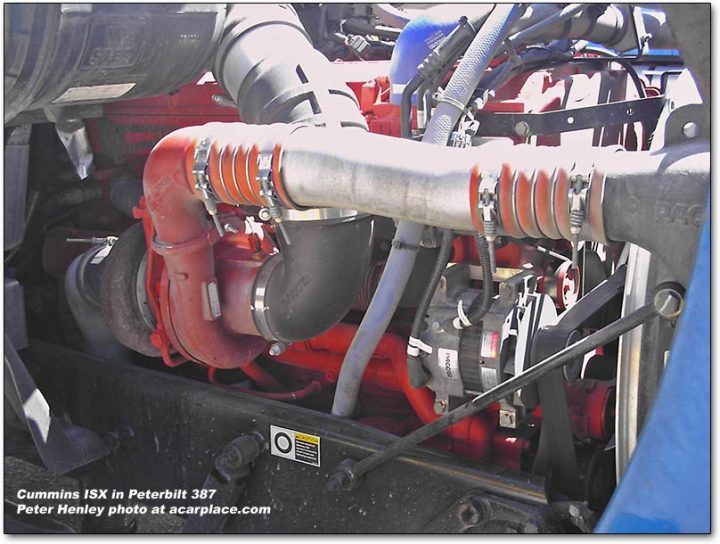
The Peterbilt’s odometer showed 100,000 miles, and time for the fourth oil change. I was near a shop that allowed me to use a bay, so I did this one myself — both to save money, and to really inspect the equipment more carefully than one can in a parking lot.

Getting the oil changed at the average truck stop or dealership shop costs between $180 and $260, often with another $25 to $75 in shop charges, environmental fees, and taxes added as well. Doing the labor myself, the oil filter, two fuel filters, and the coolant filter came to $72.82. Forty-two quarts of oil, bought in bulk, cost $78.54, and a $3 tube of grease brought the total to $154.36. That saved me an extra Franklin to give to the wife, and that always makes her happy.
I used Fleetguard filters, which is Cummins’ own brand, and Delo400 oil. The synthetic oil debate rages on in the big truck world; Delo400 is not a synthetic, but has worked well for me in a lot of different engines, and meets the requirements Cummins has laid down. Maybe synthetic is better, but it costs more, and since the warranty says that I have to change at 25,000 miles instead of at 50,000 miles, dino juice in the blue jug is certainly good enough.
None of my filter wrenches fit any of the filters. One of the shop techs was kind enough to let me use theirs.
There is plenty of room to crawl under the truck, without having to jack it up. Too many of the aerodynamic trucks are designed so that one can only get underneath in certain spots unless you have a pit or jack the truck up.

The oil drain plug is on the right side of the pan and set up so the drain pan can catch the drain oil and oil filter at the same time. That’s quite a time savings, as at least four of the 42 quarts in the ISX are in the oil filter.
After installing the new oil filter and refilling the crankcase, I moved on to the fuel filters, which netted me my first unpleasant surprise. The primary filter is on a bracket on the side of the frame, and access to it couldn’t be easier. The secondary filter is mounted on the side of the engine, and access is almost impossible due to the bracket for the primary filter, the steering shaft, and a few other accessories.
The coolant filter was a head scratcher; I searched all the common locations and couldn’t find it. One of the techs pointed it out to me, on the right side of the engine, behind a bunch of accessories. In spite of its nearly hidden location, it’s easy to change.
Chassis lube is a bit more complex than it was on my Freightliner; there are 37 grease fittings on the Pete, as opposed to the Freightliner’s 7 zerks. Freightliner seems to like factory filled and sealed components, but at between 100,000 and 400,000 miles they start failing from lack of lubrication, which means you get to spend more time in the shop getting things fixed. I prefer to lubricate things; I’ve never seen a component fail from over-lubrication. Most of the grease fittings on the 387 are easy to get at, the worst one is the right clutch cross shaft. The U joints have a neat double headed zerk that allows access in any driveshaft position.
Working with the truck, you develop an appreciation for a lot of the things that Peterbilt designed for ease of maintenance and repair. The oil fill and power steering reservoir are easy to access, although a funnel is a must if using gallon oil bottles for top-ups. I’ve never had the cap off the power steering, as you can see the level through the top of the reservoir.

The firewall is designed such that all the electrical connections are in one area and all the air lines are in another, both easy to access if repair is needed.
There are a couple of disappointments, though. The drain tubes for the HVAC box are in an awkward spot if you need to clean them out. I rerouted one of them so it wouldn’t be quite as bad, but the other is a solid copper line and there’s not much I can do with it.

Another is the windshield washer reservoir. The actual reservoir is mounted under the cab, but to fill it they installed a smaller reservoir on the firewall. The problem is that it’s easy to overfill, and the excess runs out on the ground. The problem is compounded by the location of the fill reservoir, which is right under the hood latch. On a positive note, by mounting the main reservoir under the cab, they had room for a 3 gallon reservoir, which should last more than a couple of hours when running all day on sloppy roads.
At this point, I’m pretty happy with the ease of maintenance on this truck.
